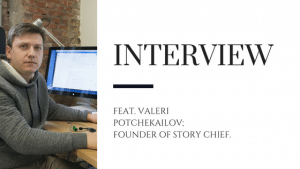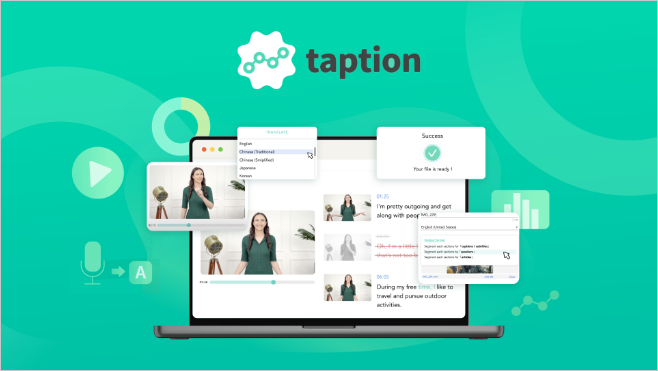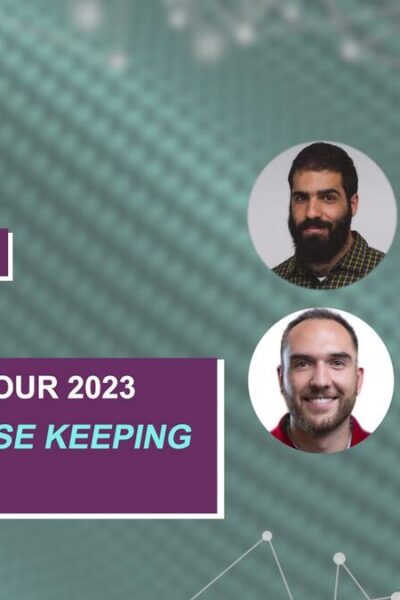When you hear the term ‘content distribution’, many people assume it is about seeding content on multiple platforms and trying to get people back to an end destination i.e. your website. This is the old way of thinking and it really comes down to making content as a standalone product which can be used to engage and drive outcomes for engaged audiences in a multiplatform (or omnichannel) world.
I’ve had the opportunity to speak with Valeri Potchekailov, Founder of Story Chief, where we discuss the current state of content distribution in digital publishing, examples of what existing publishers in Europe are doing (both good and bad), and he briefly speaks about his attempt (through Story Chief) in trying to take a unified content management and distribution approach.
Video Transcription
Vahe: Hi, everyone. This is Vahe from State of Digital Publishing. I’ve got with me Valeri from Story Chief, how are you, Valeri?
Valeri: It’s been some busy times launching Story Chief. I’m very glad that you’re interested in this as we are.
Vahe: Of course. Valeri, by the way, what Valeri is speaking about is his recent launch of Story Chief, the all-in-one content distribution editing platform that he’s put together. We’ll go through that in detail later in this conversation. Just to start off with Valeri, why don’t you just run a bit of a background about you and how you came to the point where you are today?
Valeri: I graduated as a graphic designer a couple of years ago, then I started branding and digital agency while I was a student. Since then we’ve worked with my team on a lot of cool projects from different clients here in Belgium. We also write for publishers to help them digitalize their contents for tablets and pretty much everything. We now all the processes of how it works and the struggles.
Now, we wanted to simplify this processes and make a digital publishing actually accessible for everyone who wants to write something on the web or alike. That’s about it. Now, we’ve worked last year when we did our app and we’ve just launched a week ago or something and the results are great.
Vahe: Awesome. You said about a lot of in terms of the way you work — your background, you said that a lot of it came from the magazine publishing angle and you found that you understood the challenges and struggles from there. How do you define magazine publishers where they are at now and what do you define the overall state of digital publishing?
Valeri: I think it’s all about omnichannel now. There are a lot of different channels, each audience actually has its own channel. That’s a big challenge for them because a lot of companies, they just push their articles to their own website or in their own distribution app but we think it’s really nothing else because we have seen that the read and view numbers of these articles and of the content in general, it’s just fairly low. Of course not by a few views or something.
But for local company magazines, it’s really a struggle to bring their articles to the broad public and actually monetizing them it’s even harder. Everyone has its own niche. Every magazine writes about something for their targeted audience so it’s very important to know where is your audience and to post your articles on their platforms, in their communities.
Another big one is the content is consumed mobile now and a lot of companies here in Belgium, a lot of publishers they are just not ready for this now. It’s all about actually usability also. People are very lazy so if they don’t get the contents very easily in their hands, they actually don’t make any effort to read it or even to pay for it. Actually, it’s all about bringing the right content to the right audience at the right time.
Vahe: So that, in concept sounds — that makes sense but how do you — what’s the execution you have and how you find the best way to execute that?
Valeri: First, you have to use the right tools. Then you have to test your channels and to search the right communities like Medium for example. Medium has a lot of proof in their settings and inside their platform where you can try to put your article and look for similar results and also see reporting for your own article. So you have to measure all the time what sort of stats, what’s my recommends is so important.
Vahe: If you have content — just talking about content distribution, if you syndicated that content to Medium for example, how do you make sure that you do that in an effective manner without, just like you said before, pushing content for the sake of pushing content online?
Valery: I think you will have to — in the right way, yes, you have to just rebuild your article on that platform. Yes, you can’t just push it now because there are no tools to push it there. It’s very challenging for a lot of people to do this because it’s very time consuming now. A lot of people don’t work on the channels because of this.
Because if you want to be on like 10 channels for example, if you want to put your articles on 10 different blogs and platforms, it’s very, very time-consuming. So you have to get the right tools to do it properly or work like hours and hours to put it there. But I think also per channel, you have to tweak your article a bit sometimes because each channel has its own audience.
Vahe: Do you have any case studies or examples of that content distribution done effectively especially for those people who’ve just started new or they haven’t had many audiences on those other platforms besides their own website?
Valeri: Not that I can think of, for example, but one of our clients was a distributor of print magazines, he still is actually, and it’s very niche magazine. So what they did all the time, they make their friends contents, so they make their magazines, print version of it. So they paid a designer. They pay the photographer to go take interview, photos, and stuff and they put everything together in a good design to send it to print. But then, they want to publish it to their tablets. So it’s like a kiosk app where they can sell their magazines also. The problem there is that they have to pay their designer again to make a new layout for tablets because of the tools they use and it’s very, very time-consuming. It takes up to three days to rebuild this magazine again for tablets now. Then they take some articles from there. They post it on social media and stuff. They do email sometimes and then, yes, they sometimes don’t even measure the stats and that’s it.
It’s on their website, their tablets and social media and their prints. But what we see after a couple of months is that the sales on tablets just don’t work. No one buys it just because actually it’s very tricky one because — it’s not because that people are not willing to pay for content. It’s because the tool is not accessible in other words.
You have to do — imagine if you — I think newspapers are struggling with this problem too. Imagine if you are sitting at night, you want to read some news on tablet or smartphones, it doesn’t matter, you go to the news website. You find a really nice title you want to read. You click on it. You start reading and then you see a paywall, to login to read further. I don’t know if folks in your country, in Australia, do this but in Belgium, it’s like this all the time.
Vahe: Yes, however, paid subscriptions are more commonly used.
Valeri: So imagine I have to stand up now look find my wallet, find my credit card, fill in all the details to start — I don’t want to do it because I’m just too lazy and the majority of people was. I think it’s more a technical problem for this. It’s not really something — monetizing really works if you do it right.
For example, there’s a Dutch company called Blendle. I don’t know if you know this. Blendle.com and they rethought the way people consume content actually. Now, people who never paid for content or buying or not even reading newspapers online, now are buying the content through their app. It’s very nice [crosstalk].
Vahe: How did they do that?
Valeri: So it’s just usability. So they just — it’s very well thought design of the app. So it’s not about how it looks but it’s about how it works. When you login in the app or online, you just get like, I don’t know, 5 Euro credits for free the first time and then you just immediately start. What they do, they gather all the interesting articles from different newspapers and magazines. Actually, the app knows after a while what’s your interests and they give you the best titles.
Then you just stroll like that to the articles. All of them are paid. There is no free. If one of them is good, you just do like this, swipe down or you scroll down, it’s just 3D. Meanwhile, you see on your left corner of the screen like minus ¢50. It’s like ¢50 from your card without having the stable ones. They make this very easy to process.
If you go over rapidly through the article, all the way, you get your money back. There’s a message, “Oh, you’ve been too quick and must not have read it, so here’s your ¢50.” It’s very cool. It’s not something you — it’s technical but also their copywriting in the app, it’s very accessible. It’s not like a program or a robot. It’s like a human you talk to. You have to check it out. I don’t know what it’s called. I’m not making a sale for you or something but I don’t know them. There’s a link.
Vahe: [crosstalk] You talk about usability. You talk about content usability and making sure that it works. How do you define that?
Valerie: A lot of the magazines now, a lot of publishers, still use the old ways of thinking. Actually, what you have to do if you’re in content, you monetize your company especially or a distribution company, you go to distribution services. You have to rethink the way you reach the people. It has to be very, very accessible. Actually, it’s partly because in the Blendle case, it’s not the developers who said to designers, “We’ve programmed here something. Make it look good.” Something like this.
It was really a collaboration with the designer with the developer and the publisher who knows the processes. Developer can program it and designer simplify these processes. It’s a very good collaboration between these three people. The designer has to — he knows how to make everything very accessible. He tries to, instead of three steps, he makes it one step. It’s all about accessibility actually. People are very busy. They don’t want you to make extra steps. You just have to click it and start.
Vahe: What do you define as –? You mentioned there’s an old way of thinking and now people have to start looking at new tools and new ways. What do you think are those been? What are those new tools and ways that you define?
Valeri: They don’t see a great value of putting a lot of effort in great usability designs and usability in general. They think, okay, I have content, I just have to bring it there and no matter what steps are in between. For example, in our case, for Story Chief, if someone makes an account in Story Chief, he just gets instantly a free blog. He gets a blog without having to configure anything or setting up like a server or stuff. No, it’s just there.
You just fill in your name and you have your blog. You can customize it with your photo, with your icon and stuff, and then you just click one button and you can start writing. The editor in which you write is very, very, very easy to use. You just log in and you see titles or you tap in a title, then you see your body text. You can write it or paste it from anywhere to look good. You see the plus button, so then you can insert an image or a video or embedded codes, or the hashtag, use Instagram and more.
It’s all about making it accessible to us. That’s why we have a lot of rates, a feedback because people are like, “Wow, I can really — just in three minutes, I was all set and then I can start.” Then you can push your content, not only to your blog which you got but in also to a lot of different channels. You can make your article and post it directly to your websites, to your free blog, to Medium, you make and connect such media postscripts.
You can use the new mobile channels which we — maybe we can discuss it too. The new mobile channels like, Facebook Instant, Apple News, AMP and they are all set. It’s just time — it spares you a lot of time.
Vahe: That makes sense. I guess that’s some way that definitely other publishers when they build content made to figure out how they can reduce that, the friction between people who are trying to access their content. Before we go into the mobile channels and trends that you mentioned briefly now, what do you see the overall advantages and disadvantages of content distribution?
Valeri: I think it’s very obvious, the biggest advantage is that you want your article to be seen, to actually be read. Because that was the problem with one of our clients. He had a really nice content. He had to — for print, he had his local audience, but he wanted to enlarge it. Or some blogger who writes an interesting article, but then he looks at his stats, it’s only on his website. But there are maybe a hundred Tweets or something. That’s very important.
You want to enlarge launch, actually, the content to reach people you want. You want your article to be seen. That’s the biggest advantage I can think of. You want to encourage to write more and that’s with content. For example, if you are a company, you are selling your product or service through content marketing, a lot of people what they do now is they make an article on their website then they share it with texts like, “Here, go to our website and have these products and stuff.” It’s like hard selling and stuff.
But I think you don’t have to — it doesn’t matter on which channel your content is. Actually, your article if you are selling something, your article has to solve peoples’ problem in a very explainable language without hard selling anything and you just distribute it on as many channels as possible. Your call to actions are not like like a big button, see your websites to buy it or something, no. It has to be in your article without selling actually.
Vahe: I guess the reason why I’ve asked you about the advantages and disadvantages is that people might be concerned from a negative point of view the technical limitation. For example, if you publish a content which is similar on Medium or other platforms where they have more authority than your website then they can potentially outrank you in search or they can get the lion share of the traffic. Your website might miss out on that. What are your thoughts and comments on this?
Valeri: You don’t have to encourage people to your websites through any other channel. I think it is — all the purpose is about to make your content stand on its own on all these different channels. You don’t have to send it all it back all the time to the channel to your website.
I think there is a big change. A lot of marketers work like this now, like the ones who create traffic to their sites through other channels. But I think it’s too much selling. It’s better to just try to make stories distributed on different channels. You don’t have to worry about duplicated content stuff for example because Story Chief app covers that. Technically sending people from one channel to your websites can be good but I am not really a very big fan of that. Because I think you have to make your content stand on its own and it doesn’t matter. It’s all about content which will get to people and not about people make — go to your websites.
Vahe: I’ve got to think more about the content as a product and not sort of — and where you’ve published it as standing on its own rather than seeing — works out as the end destination and trying to just syndicate it out and try to get people back to the website. I think that was my interpretation. Just in terms of the mobile, you were speaking about mobile and AMP and Facebook Instant, what’s the latest trends and developments around syndicating or publishing content and then your own respective?
Valeri: You have to two new channels but I don’t know if in Australia if that’s all new. But in Belgium it’s new, not even one paper is using it here. Those are mobile channels like Facebook Instant Pages, Google AMP. There’s also Apple News, Linkedin Posts and stuff like that.
For example, if you have an article on the website and you share it on Facebook and you swipe on your smartphone and then you see it, you click on it and then you have to wait like five seconds because your website is loading in Facebook. A lot of people are not just waiting because they are lazy and they go away. Luckily, Facebook makes Facebook as an article where when you tap on your article, it opens instantly. The rereads went up, up to 70% actually. For us, it’s a very nice channel to promote because of the loading fast.
Vahe: Yes. That’s an interesting point that you make. How do you make that the attribution for your content syndication is also set up correctly? If it’s something in the Facebook Instant or AMP or other social media channels, how do you make sure that it’s all done — besides campaign tracking which you can do the tagging, is there an easier and more effective method of doing that?
Valeri: When you post your article from Story Chief to different channels, you get the dashboards where you can see each channel together and then you can measure the stats and then see, “Okay, Facebook works fairly well.” So next time, I will write something and I will put it on Facebook. You have to actually measure all the time all these different channels and then improve, improve, improve and choose your channels which worked the best and invest in them.
Vahe: That’s a very good holistic way of looking at it I think. Because a lot of people, they look at it I think separately and they don’t understand how it all works together. But I think looking at that way that that way you can just rely on the content being as a standalone product and looking at which channels to best push it out of.
Valeri: I think you always have to measure which channel works best for you and improve and improve and improve. So you don’t waste time on channels where they have no readers.
Vahe: Valeri, just to wrap up our conversation, I want to just get your plans next plans of Story Chief, what you guys have on the roadmap, what you see the next steps in terms of a role of digital publishing for the next year and what’s your motivation and drive for the overall company?
Content from our partners
Valeri: What we really start working on is the more marketing flow in the app. So for example, we will help you to create a new content piece. The titles, for example, you will get a suggestion of a good title to use for your article and it will be based on Google Trends stats, on social media’s popularity and you can then post the same story on different channels but with different titles for example.
Vahe: Is that user-generated or is that — If can ask you how that — how you’re working towards doing that. That sounds very interesting.
Valeri: It’s all technical actually. It’s like an AI engine. Then the app will generate a marketing funnel for you, will suggest the time and also the title. So actually, it will help you to get more reads and views. That’s one of the big problems we are working on right now.
Vahe: It’s a pretty big problem that if you can solve which it will be I think pretty accessible like you said and easy for people to just be more successful.
Valeri: But we need some more data first so we are working on it right now.
Vahe: What’s the timeline for all these initiatives, core initiatives?
Valeri: Yes. I think we will see. I don’t want to rush something.
Vahe: So at least sometimes, we’re going to see — we should expect some pretty big things from the Story Chief.
Valeri: Yes, you’ll definitely hear from us more.
Vahe: Awesome. Also, that’s very cool. Valeri, thank you. It was a pleasure speaking with you. I think you covered the topic very well and the Story Chief seems to be fitting into the puzzle and trying to solve that so thank you very much.
Valeri: I hope so. I hope I was understandable. [laughs] But thank you. Thanks for the interview.
Vahe: Nice. Good luck. All the best. See you.
Valeri: Thanks.
Postscript – Valeri and I also had an email conversation about upgrading your CMS to layer it with additional functionalities that can facilitate content distribution in one single destination. For example, integrating marketing automation solutions such as Hubspot (using capture lead forms), email marketing and content performance tracking to make the entire content distribution process easier and less time-consuming.
So that’s content distribution (with examples and strategies) in a nutshell. I would love to hear your feedback and comments below about this interview, and whether having video interview features with up and coming digital publishers is of interest.












